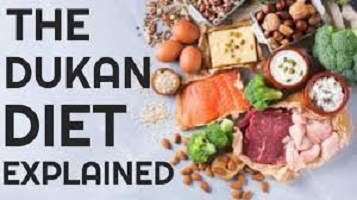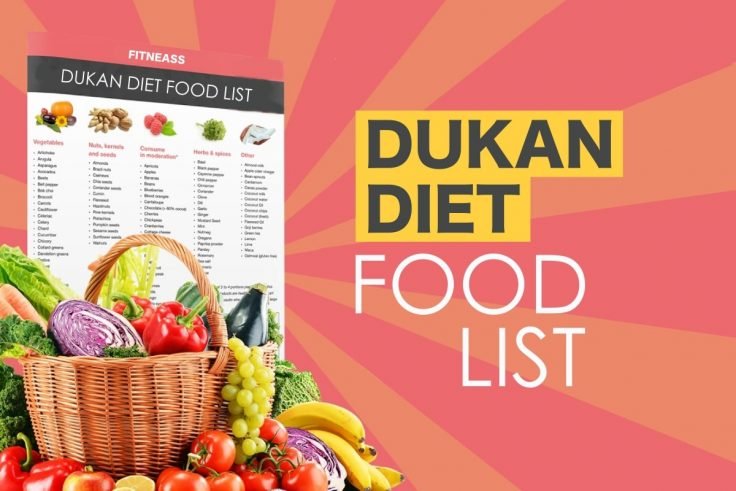Dukan Diet – Does It Work for Weight Loss?
Dukan Diet – Does It Work for Weight Loss?

Dukan Diet Meal Plan
Many folks desire rapid weight loss.
Fast weight loss, meanwhile, can be challenging to achieve and even more so to sustain.
The Dukan Diet promises quick, lasting weight loss without hunger.
You might be unsure, though, if this diet would be effective for you.
The diet is a low-carb, high-protein weight-loss regimen that is divided into four phases, much like the Atkins diet. It promises to make weight loss rapid and hunger-free.
What Is Dukan Diet?
The Dukan Diet is a four-phased, high-protein, low-carb weight loss plan.
It was developed by a French medical practitioner and expert in weight management, Dr. Pierre Dukan.
A patient with obesity who said he could give up eating anything to reduce weight—aside from meat—inspired Dukan to develop the diet in the 1970s.
Dukan wrote “The Dukan Diet” in 2000 after seeing a lot of his patients lose a lot of weight on his diet.
The book eventually saw release in 32 nations and quickly rose to prominence. It is said to have aided in quick, effortless weight loss without hunger.
The high protein, low carb Stillman Diet and the Atkins Diet both have elements in common with the Dukan Diet.
Overcome excess weight and obesity with the Dukan Diet
Take charge of your health and well-being with the Dukan Diet and choose a diet plan that takes your personal history into account if you fall into the BMI category of “obese” or “overweight.”
This will help you lose weight permanently. Figured out your BMI? It’s time to determine your True Weight at this point.
Dukan Diet Calculator ~ Calculate Your BMI
Body Mass index (BMI) is the theoretical evaluation of your health and weight precisely for your build.
It permits the identification of excess weight and obesity in adults and the risks involved, according to standards set by the World Health Organization.
The BMI is only a proxy indicator since it does not take into account muscle and bone mass.
Do you know how to calculate your BMI?
How to Calculate Your BMI
It is the ratio between your weight (W) in kg and the squared of your height (H) in meters.
IMC = W/H²
Amount of effort
The Dukan Diet necessitates a lot of work. It’s rather restricting and calls for you to take an oat bran supplement every day, especially in the beginning stages of the program.
Also, you need to keep track of how you’re doing as you move through the program’s several phases, each of which has its own unique rules and criteria.
Similar to the keto diet, the diet’s initial phases call for very few carbohydrates. Keto, on the other hand, permits greater consumption of fat, non-starchy veggies, and low-sugar fruits like berries.
In other words, there is a little bit more variety in what you can eat when you follow a ketogenic diet.
Although there are more dietary options available in later phases of the Dukan Diet, there are still several tight guidelines to follow.
Does it allow for dietary restrictions and preferences?
The Dukan Diet permits some dietary preferences and restrictions, such as avoiding gluten or dairy products. You can select foods from the lists of permitted foods for each phase that suit your dietary preferences.
However, because the diet restricts items like grains, beans, and fruit, it may be challenging for those who follow a vegetarian or vegan diet.
Dukan Stages ~ Dukan Diet Phases
The Dukan Diet begins by figuring out your target weight, or “real” weight, based on your age, past attempts at weight loss, and other variables.
The amount of weight you need to drop to attain your “actual” weight will determine how long you spend in each phase.
The Dukan diet contains four stages, which are as follows:
- Attack phase (1–7 days) – To begin the diet, consume an unlimited amount of lean protein in addition to 1.5 tablespoons of oat bran daily.
- Cruise phase (1–12 months) – Every day, add 2 tablespoons of oat bran and alternate between lean protein and non-starchy vegetables.
- The consolidation phase (which lasts for five days for each pound lost in stages 1 and 2) – 2.5 tablespoons of oat bran per day, unlimited lean protein and vegetables, some carbs and fats, and one day of lean protein each week.
- Stability phase (indefinite) – Adhere to the Consolidation phase requirements, but relax them if necessary to maintain a stable weight. Three tablespoons of oat bran should be consumed daily.
The diet is divided into two phases for weight loss and two phases for maintenance, as was already mentioned.

Dukan Diet Meal List
The Dukan Diet offers different eating patterns for each phase. You may consume the following during each.
Attack phase
Foods heavy in protein make up the majority of the Attack phase’s diet, along with a few additions that have low calories:
- eggs
- lean pork
- poultry without skin
- tofu and tempeh
- liver, kidney, and tongue
- fish and shellfish (all types)
- small amounts of lemon juice and pickles
- at least 6.3 cups (1.5 liters) of water per day (mandatory)
- 1.5 tablespoons (9 grams) of oat bran daily (mandatory)
- 1 teaspoon (5 mL) of oil daily for greasing pans
- lean beef, veal, venison, bison, and other game
- seitan, a meat substitute made from wheat gluten
- unlimited artificial sweeteners, shirataki noodles, and diet gelatin
- nonfat dairy products (restricted to 32 ounces or 1 kg per day), such as milk, yogurt, cottage cheese, and ricotta
Cruise stage
Two days are alternated in this phase.
People are only allowed to eat meals from the Assault phase on the first day. On day two, they are permitted the items from the Attack phase as well as the following vegetables:
- tomatoes
- pumpkin
- celery
- mushrooms
- bell peppers
- green beans
- turnips
- asparagus
- artichokes
- eggplant
- cucumbers
- spaghetti squash
- onions, leeks, and shallots
- 1 serving of carrots or beets daily
- spinach, kale, lettuce, and other leafy greens
- broccoli, cauliflower, cabbage, and Brussels sprouts
- 2 tablespoons (12 grams) of oat bran daily (mandatory)
No more fruits or vegetables are allowed. No fat should be added to salad dressings or used to grease cookware beyond 1 teaspoon (5 mL) of oil.
Phase of consolidation
People are urged to combine any of the foods from the Assault and Cruise stages with the following during this phase:
- Fruit – Have one serving of fruit each day, such as one cup (100 grams) of chopped berries or melon, one medium apple, orange, pear, peach, or nectarine, or two kiwis, plums, or apricots.
- Bread – Eat two slices of whole grain bread every day with a dab of low-fat butter or spread.
- Cheese – Consume one serving (1.5 ounces or 40 grams) of cheese daily.
- Starches – Consume 1-2 servings of starches each week, such as 8 ounces (225 grams) of pasta and other grains, as well as corn, beans, lentils, rice, or potatoes.
- Meat – 1-2 times a week, roast lamb, hog, or ham.
- Festive Dinners – two “celebration meals” per week, each of which consists of an appetizer, a main dish, a dessert, and a glass of wine.
- Protein Meal – One day every week dedicated to pure proteins when only foods from the Attack phase are permitted.
- Oat Bran – Daily intake of 2.5 tablespoons (15 grams) of oat bran (mandatory)
Phase of stabilization
The Dukan Diet’s stabilization phase comes after all other phases. It is crucial to keep up with the advancements made in earlier stages.
No food is technically forbidden, although there are several guidelines to abide by:
- Plan your meals using the Consolidation phase as a guide.
- Keep eating one day every week with only proteins.
- If you have the option to take the stairs, always do so.
Your friend is oat bran. Every day, consume 3 tablespoons (17.5 grams).
Typical Menu Plans
Examples of meal plans for the Dukan Diet’s initial three phases are provided below:
Attack phase
Breakfast
- Water
- Coffee or tea with nonfat milk and sugar substitute
- Nonfat cottage cheese with 1.5 tablespoons (9 grams) of oat bran, cinnamon, and sugar substitute
Lunch
- Diet gelatin
- Iced tea
- Roast chicken
- Shirataki noodles cooked in bouillon
Dinner
- Water
- Diet gelatin
- Lean steak and shrimp
- Decaf coffee or tea with nonfat milk and sugar substitute
Cruise phase
Breakfast
- Water
- Sliced tomatoes
- Three scrambled eggs
- Coffee with nonfat milk and sugar substitute
Lunch
- Iced tea
- Grilled chicken on mixed greens with low-fat vinaigrette
- Greek yogurt, 2 tablespoons (12 grams) of oat bran, and sugar substitute
Dinner
- Water
- Diet gelatin
- Baked salmon fillet
- Steamed broccoli and cauliflower
- Decaf coffee with nonfat milk and sugar substitute
Consolidation phase
Breakfast
- Water
- Coffee with nonfat milk and sugar substitute
- Omelet made with three eggs, 1.5 ounces (40 grams) of cheese, and spinach
Lunch
- Iced tea
- Turkey sandwich on two slices of whole-wheat bread
- 1/2 cup (81 grams) of cottage cheese with 2 tablespoons (12 grams) of oat bran, cinnamon, and sugar substitute
Dinner
- Water
- Roast pork
- 1 medium apple
- Grilled zucchini
- Decaf coffee with nonfat milk and sugar substitute
Is it supported by facts?
There isn’t a lot of high-quality research on the Dukan Diet.
A Dukan Diet study on Polish women found that they consumed roughly 1,000 calories and 100 grams of protein daily while shedding 33 pounds (15 kg) in 8 to 10 weeks.
While the observed weight loss may appear encouraging, it’s crucial to remember that most women need more than 1,000 calories each day.
By the most recent Dietary Guidelines for Americans, adult women should consume at least 1,600 calories daily.
Calorie restriction can have detrimental consequences on health and is challenging to sustain.
Furthermore, the majority of the weight loss seen in this trial was probably due to water loss.
Dukan diet plan
The Dukan Diet’s emphasis on high protein, low carb meals may be a factor in its success because studies have shown that diets rich in protein and low in carbs are helpful for rapid weight loss.
The advantageous effects of protein on weight are influenced by several factors.
Protein may reduce levels of the hunger hormone ghrelin while also boosting many fullness hormones.
Protein may decrease levels of the hunger hormone ghrelin while also enhancing several fullness hormones.
The Dukan Diet differs from many other high-protein diets in the same category, though, in that it limits both carbohydrates and fat.
It is a low-carb, low-fat, high-protein diet. On a low-carb, high-protein diet, however, the justification for limiting fat is not supported by scientific research.
Dukan Diet Meal Plan
Even though oat bran must be consumed every day, the Dukan Diet’s beginning phases are likewise low in fiber.
Oat bran has less than 2 grams of fiber per serving, which is a relatively tiny amount and does not offer the many health advantages, in a serving of 1.5–2 tablespoons (9–12 grams).
At 28 grams, the Daily Value for fiber is more than 10 times this amount.
Can you lose weight and gain other health benefits with the Dukan diet?
Although there aren’t many high-quality studies on the Dukan Diet, indirect evidence suggests that high-protein, low-carb diets can be successful in helping people lose weight.
The Atkins Diet, which resembles the Dukan Diet, was determined in a review of popular diets without calorie targets that were published in the journal Nutrients to be the most successful for weight loss.
According to Mary Anne Smith, MS, BSN, RN, customer success manager at Collective Medical in Austin, Texas, the Dukan diet does encourage weight loss, but it’s difficult to weight loss to sustain.
It might become monotonous and challenging to maintain when you restrict yourself to eating solely protein, she says.
However, the scientists concluded that calorie shortfall rather than macronutrient composition was most likely to blame for the weight reduction.
They also cautioned against adopting a high-protein diet because it was deficient in essential minerals such as calcium, iron, potassium, and vitamins A, C, and D. Moreover, they noted that the diet was very high in protein.
Why and who should try the Dukan diet?
Nutritionists believe that this diet is very much a fad. The diet might be useful for someone who wants to lose weight for a special occasion but doesn’t have any pre-existing medical concerns.
If you have problems controlling your eating habits, the diet offers a lot of direction and stringent regulations, which might be beneficial.
Who and why should avoid the Dukan diet?
Because of its dietary restrictions, the Dukan diet is not suggested for anyone who already has a medical issue.
According to Fitzgibbon, the hazards outweigh the advantages for persons who have diabetes, kidney illness, heart disease, or are pregnant or nursing.
For those with renal disease or who are at risk of developing kidney stones, there is too much protein; for those with heart disease, there is not enough fiber; and for those with diabetes, there is difficulty regulating insulin due to the diet.
According to Smith, other health issues include headaches, fatigue, poor breath, and constipation.
You might not be able to continue exercising since you’ll feel exhausted and foggy, she claims.
According to Harvard Medical School, the Dukan diet may potentially increase your risk for specific types of cancer, such as colon cancer, because it permits you to consume large amounts of red meat.
Is the Dukan Diet sustainable and safe?
The Dukan Diet is not a good option overall because of several difficulties with its sustainability and safety.
The safety of the Dukan Diet has hardly ever been the subject of studies.
A 2020 case study, however, revealed that two women who underwent gastric bypass surgery and the Dukan Diet and lost weight did so while also developing bilateral multiple serous pigment epithelial detachments, a disorder that alters the structure of the eye.
Regrettably, there are other problems with the Dukan Diet as well.
Overly Constrictive
Due to its stringent requirements and intricate restrictions, the Dukan Diet may be challenging to adhere to and, in the long term, may even promote disordered eating.
The diet is highly restrictive, especially on the days when only pure protein is consumed, even though the first two stages are when most people would lose weight.
According to an earlier study, women on the diet consumed 1,000 calories per day, which is far too little for any adult, even those on a weight-loss program.
Although dieters may initially see weight loss, it is doubtful that they will be able to maintain this extremely low-calorie level for very long, and it may result in additional issues.
A lack of nutritional balance
Inadequate amounts of vitamins and minerals may be present in your diet if you adhere to the Dukan Diet for a prolonged period in addition to its rigorous calorie restriction.
Also, due to their high-fat content, the Dukan Diet forgoes several nutritious sources of fiber such as avocados and almonds.
Good sources of fiber are advantageous for maintaining digestive health and lowering cholesterol.
The diet also forbids high-fat foods, even if they may be beneficial to your health.
Overall, the diet encourages an unbalanced strategy with insufficient amounts of important macronutrients, such as carbohydrates and fat.
Not tenable in the long run
All in all, the Dukan Diet is unsustainable to follow over the long term due to its extreme limitations and unbalanced food composition.
According to studies, overly tight eating plans might alter the hormones that regulate fullness and hunger, which in turn makes people feel more peckish and hungry.
Furthermore, very low-calorie diets can lower your metabolic rate, which affects how many calories you burn while at rest.
When you stop the diet, this could lead to rebound weight gain, and because the diet is so severe and restrictive, it’s unlikely that you’ll be able to follow it for very long.
Possible Disadvantages
There are issues with excessive protein intake in addition to the restrictive aspect of the diet, which could make it difficult to maintain.
Many of these worries are related to how kidney and bone health may be affected.
In the past, it was thought that consuming too much protein could harm the kidneys and weaken the bones.
The risk of consuming a lot of protein for those with healthy kidneys is still a matter of debate, and a more recent study suggests that eating a lot of protein may even strengthen bones.
However, individuals who are prone to kidney stones may see a worsening of their problem if they consume a lot of protein.
Because of this, these diets are not advised for anyone who has kidney dysfunction.
Moreover, high-protein diets typically call for drinking more water. Given the increase in protein, an earlier study suggests that the 50.7 ounces (1.5 liters) of water suggested by the Dukan Diet is probably insufficient.
Dehydration may result from the modest water consumption that is advised.
Before starting a high-protein diet, anyone with kidney issues, gout, liver illness, or other health issues should consult their doctor.
The Dukan Diet is also overly rigid and can lead to disordered eating, among other things.
FAQs

What does the Dukan Diet consist of?
The Dukan Diet is a low-carb and low-fat eating regimen centered on consuming mostly lean protein, water, and daily walks of around 20 minutes.
The premise behind most low-carbohydrate diets is that by consuming fewer carbohydrates, the body switches over to burning fat.
How much weight can you lose in a week on Dukan?
The Dukan Diet’s supporters claim that you can anticipate losing up to 4 to 6 pounds during the Assault Phase’s first week and 2 pounds each week throughout the Cruise Phase.
You’ll concentrate on weight management during the phases of consolidation and stabilization.
What can you eat in the first phase of the Dukan diet?
The Dukan diet contains four stages, which are as follows:
- Assault phase (1–7 days)
- Cruise phase (1–12 months)
- Consolidation phase
- Stabilization phase
Why is the Dukan Diet Unhealthy? The Dukan Diet’s negative aspects
Also, since you’re limiting important dietary groups like fruits, vegetables, and healthy fats, you risk developing nutritional deficiencies.
Long-term renal damage could result from a high-protein, low-carb diet because the kidneys must work harder to process such high-protein intakes.
Dukan Diet Attack Phase
You consume as much lean protein as you can handle during the “Attack” phase (1–10 days), along with 1.5 tablespoons of oat bran and at least 6 cups of water each day.
You add unlimited amounts of non-starchy vegetables every other day during the “Cruise” phase (which can last several months), along with an additional half-tablespoon of oat bran.
Dukan Diet plans free online ~ How do I start the Dukan Diet?
The Dukan Diet phases
- Attack phase (1–7 days): To begin the diet, consume an unlimited amount of lean protein in addition to 1.5 tablespoons of oat bran daily.
- Cruise phase (1–12 months): Every day, add 2 tablespoons of oat bran and alternate between lean protein and non-starchy vegetables.
- Consolidation phase: 2.5 tablespoons of oat bran per day, unlimited lean protein and vegetables, some carbs and fats, and 5 days for every pound lost in phases 1 and 2.
- Stabilization phase (indefinite): Adhere to the Consolidation phase guidelines, but relax them if necessary to maintain a stable weight. Three tablespoons of oat bran should be consumed daily.
Dukan Diet weight loss 4 weeks
According to Pierre Dukan’s diet, you can lose up to 10 pounds in the first week and then another two to four pounds each week until you reach your target weight.
That alone will persuade dieters to stick to a strict regimen that gradually introduces bread, cheese, and fruit back into the diet. Gluten-free friendly
Dukan Diet Food List ~ Dukan Diet Food List
- Lean game meats like bison, venison, and veal.
- Lean pork.
- Skinless chicken.
- The tongue, kidney, and liver
- Shellfish and fish (all types)
- Eggs
- Nonfat dairy products, such as milk, yogurt, cottage cheese, and ricotta (limited to 32 ounces or 1 kg per day).
- Tempeh and tofu.
What is the 3-day Dukan diet?
For every pound they want to lose, it lasts for 3 days.
Low-fat proteins and nonstarchy vegetables, such as spinach, okra, lettuce, and green beans, are both permissible in unlimited quantities.
The diet calls for them to consume 2 tablespoons of oat bran and engage in 30 to 60 minutes of daily exercise during the cruise phase.


